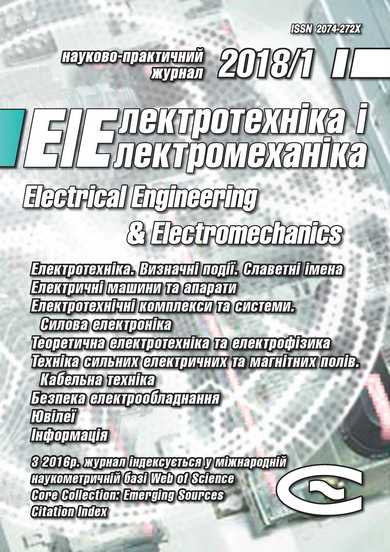NEW HYPOTHESIS AND ELECTROPHYSICS NATURE OF ADDITIONAL MECHANISMS OF ORIGIN, ACCUMULATION AND DIVISION OF ELECTRIC CHARGES IN THE ATMOSPHERIC CLOUDS OF EARTH
DOI:
https://doi.org/10.20998/2074-272X.2018.1.07Keywords:
atmospheric electricity, new mechanisms of origin, accumulation and division of electric charges in atmospheric clouds, hypothesis, calculation, experimental dataAbstract
Purpose. Development of new hypothesis about the possible additional mechanisms of origin, accumulation and division of electric charges in atmospheric clouds, containing shallow dispersible drops of water, shallow particulate dielectric matters and crystals of ice. Methodology. Electrophysics bases of technique of high voltage, theoretical bases of the electrical engineering, theoretical electrophysics, theory of the electromagnetic field, technique of the high electric and magnetic fields. Results. Pulled out and grounded new scientific supposition, related to possible existence in earthly troposphere of additional mechanisms of origin, accumulation and division of electric charges in the atmospheric clouds of Earth, being based on electrization in the warm ascending currents of air of shallow round particulate dielectric matters, getting in an air atmosphere from a terrene and from the smoke extras of industrial enterprises. By a calculation a way it is shown that the offered additional electrophysics mechanisms are able to provide achievement in the atmospheric clouds of such values of volume closeness of charges, total electric charge and tension of the electrostatic field stocked in them inwardly and on the external border of storm clouds which correspond modern experimental information from an area atmospheric electricity. The calculation estimations of levels of electric potential and stocked electric energy executed on the basis of the offered hypothesis in storm clouds specify on possibility of receipt in them of ever higher electric potentials and large supplies of electric energy. The obtained results are supplemented by the known approaches of forming and development in earthly troposphere of the electric charged atmospheric clouds, being based on electrization in the warm ascending streams of air the masses of shallow round aquatic drops. Originality. First on the basis of the well-known theses of technique and electrophysics of high voltage the important role of shallow round particulate dielectric matters, electrifiable in the warm ascending currents of air of troposphere is scientifically grounded, in the processes of origin, accumulation and division of electric charges in the stratified-rain, heap rain and storm clouds of Earth. Practical value. Application of in practice findings will allow to deepen scientific and technical knowledge of humanity in area of nature of atmospheric electricity, will be instrumental in further development of physics of linear lightning, decision of global problem of lightning protection of earthly technosphere, and also development of the specified approaches at description of the scantily explored people electrophysics phenomena and theories of thunderstorm at sandy storms in the numerous deserts of the world and powerful smoke eruptions of volcanoes on Earth.References
1. Radovskiy M.I. Lomonosov and his researches in area of atmospheric electricity. Electricity, 1939, no.1, pp. 69-72. (Rus).
2. Kapitza P.L. Nauchnaja dejatel’nost’ V. Franklina [Scientific activity of V. Franklin]. Uspekhi Fizicheskih Nauk, 1956, vol.58, no.2, pp. 169-182. (Rus). doi: 10.3367/ufnr.0058.195602a.0169.
3. Bortnik I.M., Beloglovskiy A.A., Vereshchagin I.P., Vershinin Yu.N., Kalinin A.V., Kuchinskiy G.S., Larionov V.P., Monastyrskiy A.E., Orlov A.V., Temnikov A.G., Pintal' Yu.S., Sergeev Yu.G., Sokolova M.V. Elekrophizicheskie osnovy techniki vysokih naprjazhenij [Electrophysics bases of technique of high voltage]. Moscow, Publishing house of MEI, 2010. 704 p. (Rus).
4. Bol'shoj illjustrirovannyj slovar' inostrannyh slov [Large illustrated dictionary of foreign words]. Moscow, Russkie slovari Publ., 2004. 957 p. (Rus).
5. Bazelyan E.M, Raiser Yu.P. Fizyka molnii i molnyezashchita [The physics of lightning and lightning protection]. Moscow, Fizmatlit Publ., 2001. 319 p. (Rus).
6. Uman M.A. Natural and artificially-initiated lightning and lightning test standards. Proceedings of the IEEE, 1988, vol.76, no.12, pр. 1548-1565. doi: 10.1109/5.16349.
7. Kuzhekin I.P., Larionov V.P., Prohorov E.N. Molnija i molniezashchita [Lightning and protection from lightning]. Moscow, Znak Publ., 2003. 330 p. (Rus).
8. Kravchenko V.I. Molniya. Elektromahnitny faktory i porazhayushchie vozdeystviya na tekhnycheskie sredstva [Lightning. Electromagnetic factors and their impact on the striking technical objects]. Kharkov, NTMT Publ., 2010. 292 p. (Rus).
9. Available at: http://www.astronet.ru/db/msg/1244664 (accessed 15 July 2012). (Rus).
10. Kuz'michev V.E. Zakony i formuly fiziki [Laws and formulas of physics]. Kiev, Naukova Dumka Publ., 1989. 864 p. (Rus).
11. Baranov M.I. Estimation of induction electric charges thickness in a metallic conductor. Electrical engineering & electromechanics, 2011, no.4, pp. 56-58. (Rus). doi: 10.20998/2074-272X.2011.4.11.
12. Javorskij B.M., Detlaf A.A. Spravochnik po fizike [Handbook of physics]. Moscow, Nauka Publ., 1990. 624 p. (Rus).
13. Brzhezitskiy V.A., Іsakova A.V., Rudakov V.V. Tekhnika i elektrofizyka vysokykh napruh [Technics and Electrophysics of High Voltages]. Kharkov, Tornado Publ., 2005. 930 p. (Ukr).
Downloads
Published
How to Cite
Issue
Section
License
Copyright (c) 2018 M. I. Baranov

This work is licensed under a Creative Commons Attribution-NonCommercial 4.0 International License.
Authors who publish with this journal agree to the following terms:
1. Authors retain copyright and grant the journal right of first publication with the work simultaneously licensed under a Creative Commons Attribution License that allows others to share the work with an acknowledgement of the work's authorship and initial publication in this journal.
2. Authors are able to enter into separate, additional contractual arrangements for the non-exclusive distribution of the journal's published version of the work (e.g., post it to an institutional repository or publish it in a book), with an acknowledgement of its initial publication in this journal.
3. Authors are permitted and encouraged to post their work online (e.g., in institutional repositories or on their website) prior to and during the submission process, as it can lead to productive exchanges, as well as earlier and greater citation of published work.





